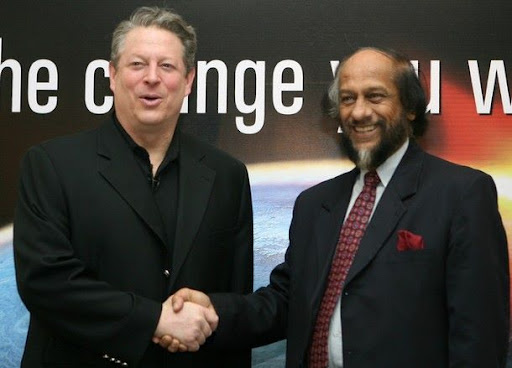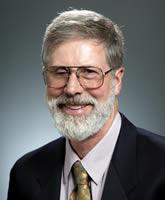Imagine a ball rolling down an incline then hitting the bottom which is completely flat, totally level. We all know that eventually the ball will stop. The gravity that caused the ball to roll is no longer influencing it but why does it stop, why doesn't it just roll forever? Friction, the contact of the ball to the surface creates friction which eventually stops the ball.
In this case the friction which stops the ball is called a negative feedback, without the negative feedback of friction the momentum of the ball initially caused by the gravity would just go on rolling until some other force stopped it.
What is little understood by the general public in regards to global warming is that carbon dioxide (CO2) by itself can only heat the Earth so much, it is not like adding fuel to the fire, as a matter of fact the more CO2 that is put into the atmosphere, the less that the CO2 is capable of heating. In a sense it saturates it's ability to warm. This is why you hear the discussion on CO2 discussed in terms of "doubling of CO2 from pre-industrial levels" when you reach that point you have pretty much reached the limit of what CO2 can do as far as heating the atmosphere on it's own.
This is not in dispute, from IPCC Fourth Assessment Report: Climate Change 2007 (AR4)
If the amount of carbon dioxide were doubled instantaneously, with everything else remaining the same, the outgoing infrared radiation would be reduced by about 4 Wm-2. In other words, the radiative forcing corresponding to a doubling of the CO2 concentration would be 4 Wm-2. To counteract this imbalance, the temperature of the surface-troposphere system would have to increase by 1.2°C (with an accuracy of ±10%), in the absence of other changesSo as you can see a doubling of CO2 would only account for a 1.2 C of warming-period. This is not in dispute. So why do you hear all these claims that increased CO2 is going to warm the Earth by anywhere from 2-6 degC? The IPCC explains:
In reality, due to feedback, the response of the climate system is much more complex. It is believed that the overall effect of the feedback amplifies the temperature increase to 1.5 to 4.5°C. A significant part of this uncertainty range arises from our limited knowledge of clouds and their interactions with radiation.So in order to keep the ball rolling they postulate feedback, in this case positive feedback which amplifies the heating caused by the initial heating of increased CO2. Note the caution they put on this based on clouds, perhaps a future topic, but what is it that amplifies that 1.2 degrees into dangerous temperatures which will destroy life as we know it? From the IPCC:
The so-called water vapor feedback, caused by an increase in atmospheric water vapor due to a temperature increase, is the most important feedback responsible for the amplification of the temperature increase.
To summarize, a doubling of CO2 will cause the temperature to increase by 1.2 degC, this increased temperature will then cause more evaporation of water vapor (the primary greenhouse gas) into the atmosphere which will amplify the effect of the CO2 caused warming, got it? This is known as the "enhanced greenhouse effect".
It is as if having reached the bottom of the hill our ball creates its own jet propulsion which overcomes the negative feedback of friction and keeps on going.
I mention all this in order that you may understand why the historical temperature records are so important. You see, in order for the enhanced greenhouse effect to work as a theory, it must work regardless of the agent of temperature increase.
To put it simply, according to the theory, at some point the Earth's atmosphere will reach that famous tipping point temperature which will cause this chain reaction (the enhanced greenhouse effect) and it really does not matter how the Earth's atmosphere reaches that tipping point, only that it does-then we are cooked. It is not the CO2 that will increase temperatures, it is the increased water vapor. This also assumes that nature will not have some other negative feedback to counteract the warming temperatures, such as increased clouds.
The entire enhanced greenhouse effect theory is a sham, but let's assume that it is not. In order for the alarmist to justify drastic action they must convince policy makers and the public that the current temperatures are unprecedented. Why ? Simply because if in the past had the Earth's temperatures been as high or higher than today for extended periods, then the enhanced greenhouse effect should have kicked in regardless of how the temperatures reached that tipping point.
This is one important reason why the e-mails and data released are so important to the science question. These scientist were manipulating the historical record of past climate changes. It is not just that temperatures in the past were warmer without you driving your SUV, it goes to the very heart of the entire theory. If for example as was accepted prior to the AGW nonsense infecting science, the Medieval Warming Period was warmer than today, as was accepted until these guys got their hands and agenda on the data and the process, why did we not have runaway warming? Where was the enhanced greenhouse effect while they were making wine in England?
This is also why having proponents and advocates for an unproven theory also being the keepers of the records and the gatekeepers of the process by which the science is examined is so dangerous. It is as if my wife (a teacher) allowed her students to grade their own papers and worse they were paid based on the grades they received.
This is also why the scientist who promote this theory are so unscrupulous, they know this theory and the flaws in it. They know that the entire global warming hypothesis is a two step process yet they allow the public to believe, if not out right promote the idea, that carbon dioxide alone is going to trap the heat which will melt Santa's home and drown Polar Bears. They do this without making clear to the public that carbon dioxide itself is a harmless but critically important ingredient necessary to life on this planet and that only their unproven "second step" hocus pocus theory will cause the dangerous warming which they can neither accurately quantify and which is subject to a multitude of variables "this uncertainty range arises from our limited knowledge of clouds and their interactions with radiation."
Do you believe that the public at large understands that CO2 by itself could do little more than warm the planet to more comfortable productive environment. Do you believe that the public at large understands that the reported "settled" science is just chock full of "uncertainty". Uncertainty that is possibly (probably) so large as to make this theory basically worthless. Do you believe the so called scientist who promote this theory as fact have adequately explained this to policy makers and the public? Or have they promoted an agenda and hidden the simple facts about their theory which are as easily explained as a child's ball rolling down a hill.
Update: One not quite insignificant point I wanted to make but forgot is about this one assertion in the IPCC literature quoted above:\
It is believed that the overall effect of the feedback amplifies the temperature increase
Does this sound convincing or even scientific, "it is believed" ? Obviously it is not proven, which it is not, or they would have stated that. The best they can do is give ranges of what they believe this feedback will be which is called climate sensitivity, Upon that belief the entire theory rests. It is also that "belief" or assumption which is fed into the computer models which forecast global warning. without this "belief" the entire theory falls apart.







